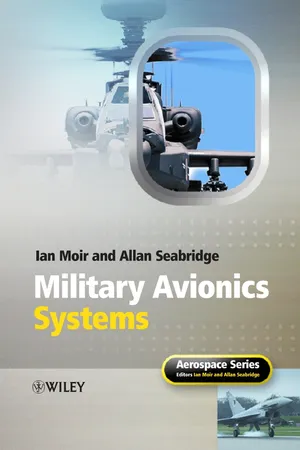
- English
- ePUB (mobile friendly)
- Available on iOS & Android
Military Avionics Systems
About this book
Ian Moir and Allan Seabridge
Military avionics is a complex and technically challenging field which requires a high level of competence from all those involved in the aircraft design and maintenance. As the various systems on board an aircraft evolve to become more and more inter-dependent and integrated, it is becoming increasingly important for designers to have a holistic view and knowledge of aircraft systems in order to produce an effective design for their individual components and effectively combine the systems involved.
This book introduces the military roles expected of aircraft types and describes the avionics systems required to fulfil these roles. These range from technology and architectures through to navigations systems, sensors, computing architectures and the human-machine interface. It enables students to put together combinations of systems in order to perform specific military roles.
- Sister volume to the authors' previous successful title 'Civil Avionics Systems'
- Covers a wide range of military aircraft roles and systems applications
- Offers clear and concise system descriptions
- Includes case studies and examples from current projects
- Features full colour illustrations detailing aircraft display systems
Military Avionics Systems will appeal to practitioners in the aerospace industry across many disciplines such as aerospace engineers, designers, pilots, aircrew, maintenance engineers, ground crew, navigation experts, weapons developers and instrumentation developers. It also provides a valuable reference source to students in the fields of systems and aerospace engineering and avionics.
Frequently asked questions
- Essential is ideal for learners and professionals who enjoy exploring a wide range of subjects. Access the Essential Library with 800,000+ trusted titles and best-sellers across business, personal growth, and the humanities. Includes unlimited reading time and Standard Read Aloud voice.
- Complete: Perfect for advanced learners and researchers needing full, unrestricted access. Unlock 1.4M+ books across hundreds of subjects, including academic and specialized titles. The Complete Plan also includes advanced features like Premium Read Aloud and Research Assistant.
Please note we cannot support devices running on iOS 13 and Android 7 or earlier. Learn more about using the app.
Information
1
Military Roles
1.1 Introduction

Table of contents
- Cover
- Table of Contents
- Series Preface
- Acknowledgements
- About the Authors
- Introduction
- 1 Military Roles
- 2 Technology and Architectures
- 3 Basic Radar Systems
- 4 Advanced Radar Systems
- 5 Electrooptics
- 6 Electronic Warfare
- 7 Communications and Identification
- 8 Navigation
- 9 Weapons Carriage and Guidance
- 10 Vehicle Management Systems
- 11 Displays
- Bibliography
- Glossary
- Index
- End User License Agreement